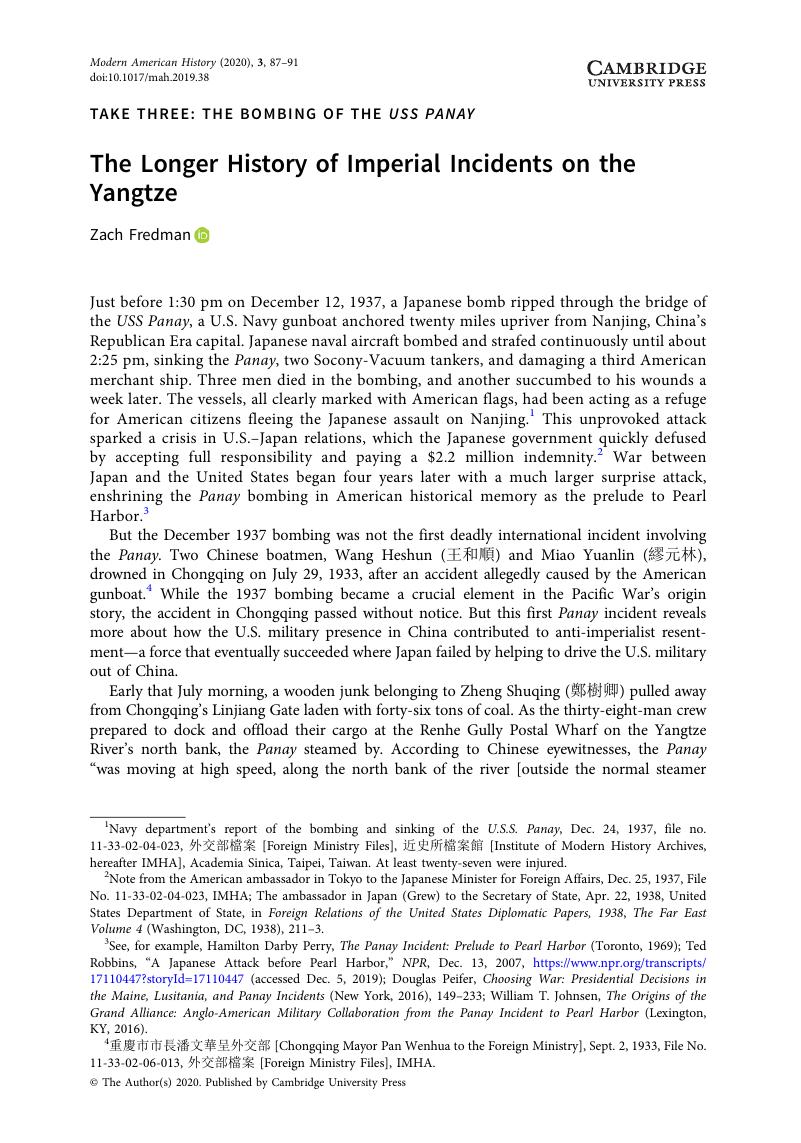No CrossRef data available.
Article contents
The Longer History of Imperial Incidents on the Yangtze
Published online by Cambridge University Press: 16 March 2020
Abstract

- Type
- Take Three: The Bombing of the USS Panay
- Information
- Copyright
- Copyright © The Author(s) 2020. Published by Cambridge University Press
References
1 Navy department's report of the bombing and sinking of the U.S.S. Panay, Dec. 24, 1937, file no. 11-33-02-04-023, 外交部檔案 [Foreign Ministry Files], 近史所檔案館 [Institute of Modern History Archives, hereafter IMHA], Academia Sinica, Taipei, Taiwan. At least twenty-seven were injured.
2 Note from the American ambassador in Tokyo to the Japanese Minister for Foreign Affairs, Dec. 25, 1937, File No. 11-33-02-04-023, IMHA; The ambassador in Japan (Grew) to the Secretary of State, Apr. 22, 1938, United States Department of State, in Foreign Relations of the United States Diplomatic Papers, 1938, The Far East Volume 4 (Washington, DC, 1938), 211–3Google Scholar.
3 See, for example, Perry, Hamilton Darby, The Panay Incident: Prelude to Pearl Harbor (Toronto, 1969)Google Scholar; Ted Robbins, “A Japanese Attack before Pearl Harbor,” NPR, Dec. 13, 2007, https://www.npr.org/transcripts/17110447?storyId=17110447 (accessed Dec. 5, 2019); Peifer, Douglas, Choosing War: Presidential Decisions in the Maine, Lusitania, and Panay Incidents (New York, 2016), 149–233Google Scholar; Johnsen, William T., The Origins of the Grand Alliance: Anglo-American Military Collaboration from the Panay Incident to Pearl Harbor (Lexington, KY, 2016)CrossRefGoogle Scholar.
4 重慶市市長潘文華呈外交部 [Chongqing Mayor Pan Wenhua to the Foreign Ministry], Sept. 2, 1933, File No. 11-33-02-06-013, 外交部檔案 [Foreign Ministry Files], IMHA.
5 Ibid.; 證明書 [Witness Statement], undated, signed by Li Ziqing (李子清), Lai Yinhe (賴銀和), Wang Qingyun (王慶雲), Zhou Changhai (周昌海), Fu Yingcheng (傅銀成), Zhang Guangjie (張光傑), and Zhang Chaolu (張朝祿), Oct. 24, 1933, file no. 11-33-02-06-013, 外交部檔案 [Foreign Ministry Files], IMHA.
6 計抄美潘南兵船浪沉炭船人損失價值單 [Statement of Damages from the Sinking of a Coal Junk by the U.S.S. Panay], Sept. 2, 1933, file no. 11-33-02-06-013, 外交部檔案 [Foreign Ministry Files], IMHA.
7 Clarence E. Gauss, Counselor of Legation at Peking to Wang Chao-Ming, Acting Minister for Foreign Affairs, Nov. 17, 1933, file no. 11-33-02-06-013, 外交部檔案 [Foreign Ministry Files], IMHA.
8 Statement of Damages from the Sinking of a Coal Junk by the U.S.S. Panay, Sept. 2, 1933, file no. 11-33-02-06-013, 外交部檔案 [Foreign Ministry Files], IMHA.
9 U.S. naval patrols in the Yangtze began in 1854. See Kemp, Tolley, Yangtze Patrol (Annapolis, MD, 1971)Google Scholar.
10 During Chiang Kai-shek's Northern Expedition (1926–1928), for example, the U.S. Navy sent seventeen destroyers, eleven submarines, and three cruisers to China, along with mine sweepers and numerous support vessels. For a helpful primary source on the prewar naval presence, see Annual Reports of the Navy Department, River Patrol and Other U.S. Navy Asiatic Fleet Activities in China, as Described in the Annual Reports of the Navy Department, 1920, https://www.history.navy.mil/research/library/online-reading-room/title-list-alphabetically/y/yangtze-river-patrol-and-other-us-navy-asiatic-fleet-activities-in-china.html (accessed Dec. 5, 2019).
11 Cornebise, Alfred Emile, The United States 15th Infantry Regiment in China, 1912–1938 (Jefferson, NC, 2004)Google Scholar; Clark, George B., Treading Softly: U.S. Marines in China, 1819–1949 (Westport, CT, 2001), 56–77Google Scholar.
12 Bickers, Robert, Out of China: How Chinese Ended the Era of Western Domination (Cambridge, MA, 2017), 271–2CrossRefGoogle Scholar.
13 Romanus, Charles and Sunderland, Riley, Stilwell's Mission to China (Washington, DC, 1953), 27Google Scholar.
14 Mao Zedong, “Report to the 2nd National Congress of Workers and Peasants Representatives,” Jan. 23, 1934, https://www.marxists.org/reference/archive/mao/selected-works/volume-6/mswv6_18.htm#s3 (accessed Dec. 5, 2019).
15 Kai-shek, Chiang and Jaffe, Philip, China's Destiny and Chinese Economic Theory (1943; Leiden, 2012), 80–1Google Scholar.
16 Bickers, Out of China, 107.
17 Chiang, China's Destiny, 79.
18 被傷害華人償卹表 [List of Indemnities Paid to Injured Chinese], Mar. 18, 1937, file no. 11-33-02-06-013, 外交部檔案 [Foreign Ministry Files], IMHA.
19 Bickers, Out of China, 17.
20 Coffman, Edward M., “The American 15th Infantry Regiment in China, 1912–1938: A Vignette in Social History,” Journal of Military History 58, no. 1 (Jan. 1994): 70–2CrossRefGoogle Scholar.
21 Office of the Brigade Provost Marshall, Third Brigade, Tientsin, China, “Report of Investigation of the Assault Made Upon the Proprietress of the Chicago Bar,” Jan. 10, 1929; U.S. Congress, House of Representatives, Document no. 117, 4th Cong., 1st sess., Mar. 4, 1935, file no. 11-33-02-06-013, 外交部檔案 [Foreign Ministry Files], IMHA.
22 Chiang, China's Destiny, 80.
23 Fredman, Zach, “Lofty Expectations and Bitter Reality: Chinese Interpreters for the U.S. Army during the Second World War,” Frontiers of History in China 12, no. 4 (2017): 585–90Google Scholar; Fredman, Zach, “GIs and ‘Jeep Girls’: Sex and American Soldiers in Wartime China,” Journal of Modern Chinese History 13, no. 1 (2019): 76–101CrossRefGoogle Scholar.
24 The Chinese Ministry for Foreign Affairs, “Regulations Governing the Handling of Criminal Offenses Committed by Members of the Armed Forces of the United States in China,” Oct. 1, 1943, in Foreign Relations of the United States; Diplomatic Papers, 1943, China (Washington, DC, 1957), 699–700Google Scholar.
25 Gallicchio, Marc, The Scramble for Asia: U.S. Military Power in the Aftermath of the Pacific War (Lanham, MD, 2008), 132–6Google Scholar; Zhang, Hong, America Perceived: The Making of Chinese Images of the United States, 1945–1953 (Westport, CT, 2002), 77–111Google Scholar.
26 上海市警察局關於美軍機關對美帝侵略軍在上海肇事的調查 [Shanghai Police Bureau Report on Incidents Involving American Servicemen in Shanghai], Dec. 14, 1945 to Mar. 18, 1946, file no. Q131-20-3, 1–187, Shanghai Municipal Archives, Shanghai, China.
27 Zhang Mochao et al. 中国现代史 [Modern Chinese History] (Chongqing, 1996), 616.
28 Yang, Zhiguo, “U.S. Marines in Qingdao: History, Public Memory, and Chinese Nationalism,” in Exploring Nationalisms of China: Themes and Conflicts, eds. Wei, C. X. George and Liu, Xiaoyuan (Westport, CT, 2002), 61–62Google Scholar.
29 Johnson, Matthew D., “Anti-Imperialism as Strategy: Masking the Edges of Foreign Entanglements in Civil War-Era China, 1945–1945,” in Overcoming Empire in Post-Imperial East Asia: Repatriation, Redress and Rebuilding, eds. Kushner, Barak and Muminov, Serzod (London, 2019), 124, 127–31, 138–40Google Scholar.
30 Westad, Odd Arne, Decisive Encounters: The Chinese Civil War, 1946–1950 (Stanford, CA, 2003), 140–1Google Scholar.
31 For an overview of the propaganda campaign see 侯松涛 Hou Songtao, “抗美援朝运动与民众社会心态研究” [The Resist American and Aid Korea Campaign and Mass Social Attitudes in China], 中共党史研究 [Party History Research] (2005年第二期): 19–28.


